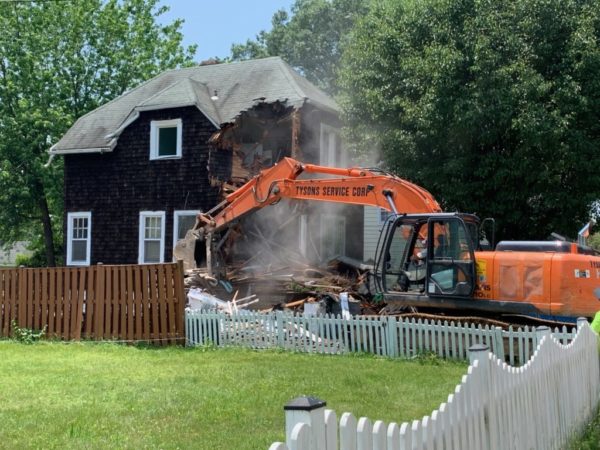Progressive Voice is a weekly column. The views and opinions expressed in the column are those of the individual authors and do not necessarily reflect the views of their organizations or ARLnow.com.
By Laura Saul Edwards
What’s a surefire way to get people talking in Arlington? Tear down an old house and replace it with still another McMansion that will be listed for more than a million dollars on the market.
“In neighborhoods across Arlington last year — at the doors, in coffees, and at civic associations — I heard concern regarding the size of single family homes being built to replace smaller, older homes,” confirmed County Board member Matt de Ferranti recently.
Meanwhile, teardowns continue. Neighbors and passersby watch an excavator methodically rip apart an old house, and they wonder how much the new house will affect the neighborhood, the environment, flooding and school crowding.
In one recent teardown, an approximately 1,500 square-foot home built before WWII was demolished, and all the surrounding trees were cleared, to make way for a new house more than triple the size of the one it replaces.
What can be done about this trend?
“While we can and should respect individual property rights, we also should recognize the impacts large homes can have on our neighbors, including storm water runoff,” de Ferranti said. “We must make sure the regulations are enforced, monitor and update our own ordinances, and work to obtain additional authority from Richmond, where appropriate, to make sure Arlington remains a sustainable place to live.”
The high price of land in Arlington and Virginia’s strong property rights laws generally mean a homebuilder will construct the largest allowable house to maximize economic value. Sales figures validate market demand for these large homes. Moreover, some of Arlington’s small older homes are too decrepit and outdated to make renovation a practical option.
This doesn’t mean, however, the county’s footprint and height allowances can’t be reviewed or tightened. The last time the County Board dug into this issue was in 2005, when Arlington’s 1950 zoning ordinance was amended to reduce the maximum lot coverage for single-family homes.
“Home sizes that were once the theoretical maximum are now the de facto minimum for new home rebuilds,” observed County Board member Erik Gutshall. “Arlington needs to initiate the modernization of our zoning ordinance with a frank discussion of just what character do we want in our neighborhoods.”
Longtime Arlington real estate agent Bob Adamson said, “Affordability is a worthy aspiration. Economic feasibility is crucial. The devil resides in the details.”
Updating Arlington’s zoning and land use requirements for single-family homes could be a genuine success story if it identifies practical, feasible changes responsive to factors that vary across the county, such as topography and lot size — while also honoring the rights of property owners.
Chad Hackmann, a homebuilder who has worked in Arlington for 20 years, said, “I think changing zoning and lot coverage to force smaller homes would be a can of worms.” He noted, “Arlington has, in general, smaller lots than other jurisdictions in Northern Virginia so if you changed lot coverage you would pushdown renovation work as well, which I think you want to encourage.”
However, if zoning changes were being contemplated, “I think slightly increasing density in areas that make sense would go a long way,” Hackmann said. “We have areas in Arlington that, because of their location on busy roads or whatever, are not as attractive for those looking for single-family homes. They would be more attractive if we could loosen up zoning and allow for small multi-family homes in those certain areas.”
It is also possible that when “non-conforming” homes (built before the zoning of the 1950s went into effect) in certain areas are renovated or rebuilt, some greater zoning flexibility could be contemplated.
“Whatever zoning changes are proposed, attention needs to be paid to the ultimate property value,” said Adamson. “Bad decisions could lead to a drop in property value that might be painful. In addition, it would result in lower property tax revenues. The County should not rush into hasty changes that could have such negative impacts.”
As County Board member Gutshall observed, “If the car-centric suburbs of the 1950s are to evolve into sustainable, walkable communities of the 21st century, then our land use policies should evolve too. We need to prioritize a diversity of housing forms and inclusive household types, energy efficiency and sustainable building materials, access to transit and neighborhood shopping nodes, and quality green space.”
Yes, let’s keep talking, but also — the hard part — let’s make some positive changes happen.
Laura Saul Edwards has lived in Arlington County since 1994. She served on the School Board’s Advisory Council on School Facilities and Capital Projects (FAC) and is an APS 2012 Honored Citizen.


